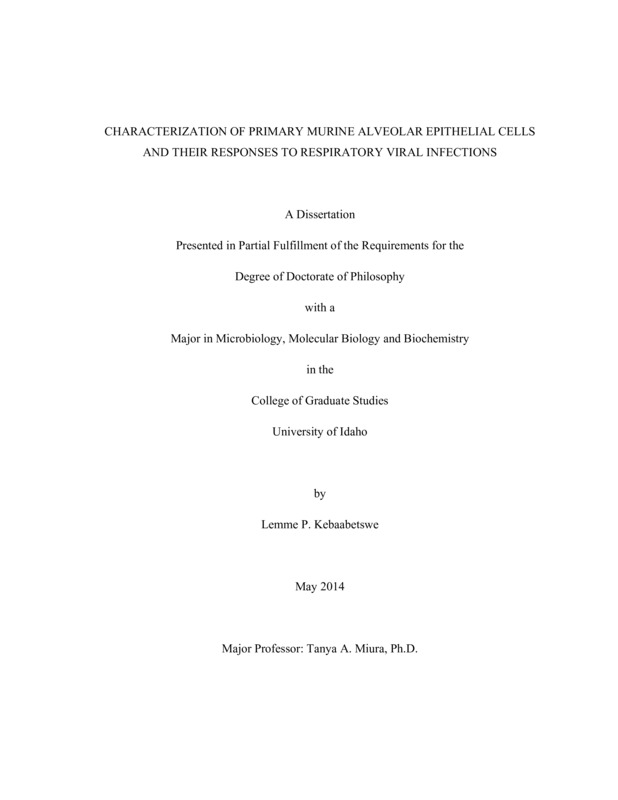Characterization of Primary Murine Alveolar Epithelial Cells and their Responses to Respiratory Viral Infections
Kebaabetswe, Lemme Prica. (2014). Characterization of Primary Murine Alveolar Epithelial Cells and their Responses to Respiratory Viral Infections. Theses and Dissertations Collection, University of Idaho Library Digital Collections. https://www.lib.uidaho.edu/digital/etd/items/kebaabetswe_idaho_0089e_10258.html
- Title:
- Characterization of Primary Murine Alveolar Epithelial Cells and their Responses to Respiratory Viral Infections
- Author:
- Kebaabetswe, Lemme Prica
- Date:
- 2014
- Keywords:
- Alveolar epithelial cells Cytokines Influenza A virus Mouse hepatitis virus Type I cells Type II cells
- Program:
- Biology
- Subject Category:
- Microbiology; Immunology; Virology
- Abstract:
-
Abstract
Alveolar epithelial cells are important targets of respiratory viral infections that cause severe diseases in the lung. The alveolar epithelium, which covers more than 99% of the large internal surface area of the lung, is composed of two morphologically distinct cell types. The alveolar type I (ATI) cells are large thin cells that function in gas exchange. The alveolar type II (ATII) cells are cuboidal and produce surfactant that is required to prevent collapse of the air spaces. ATII cells divide and transdifferentiate into ATI cells to repair damaged epithelium. Both ATI and ATII cells are infected by viruses and contribute to cytokine production during infection. The goal of this dissertation was to establish an in vitro model of murine ATI and ATII cells and determine their susceptibility and responses to infection by respiratory viruses used in murine models: influenza A virus strain PR8 and murine coronavirus, MHV-1. Isolated ATII cells were cultured to maintain an ATII phenotype as determined by expression of LBP180 or transdifferentiate into an ATI-like cell phenotype determined by expression of T1α. Primary cultures of either phenotype supported replication of PR8 and MHV-1. Further, both viruses induced cytokine expression by ATI cells. Expression of several cytokines and chemokines were induced by both viruses, while MHV-1 infection resulted in expression of an additional set of cytokines that were not expressed by PR8-infected cells. To help better understand the dynamics of PR8 and cellular proteins interactions, proteomics analysis using liquid chromatography-tandem mass spectrometry was examined on ATII cells. Protein profiles in PR8 infected and uninfected ATII cells were compared. Influenza disrupted various functional classes of proteins that may allow productive infection of ATII cells, altering their homeostatic functions. These data will help identify cellular proteins whose functions in the virus life cycle could be targeted for antiviral strategies. Moreover, differentiated cultures of murine alveolar epithelial cells will be critical for identifying mechanisms of viral damage to the alveolar epithelium during respiratory infections, by providing an in vitro model to perform mechanistic studies that can be correlated with in vivo studies in well-established murine models.
- Description:
- doctoral, Ph.D., Biology -- University of Idaho - College of Graduate Studies, 2014
- Major Professor:
- Miura, Tanya A
- Committee:
- Fortunato, Elizabeth; Minnich, Scott A; Cole, Douglas
- Defense Date:
- 2014
- Identifier:
- Kebaabetswe_idaho_0089E_10258
- Type:
- Text
- Format Original:
- Format:
- application/pdf
- Rights:
- In Copyright - Educational Use Permitted. For more information, please contact University of Idaho Library Special Collections and Archives Department at libspec@uidaho.edu.
- Standardized Rights:
- http://rightsstatements.org/vocab/InC-EDU/1.0/

